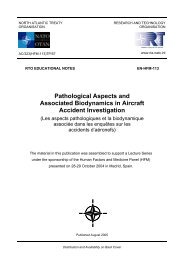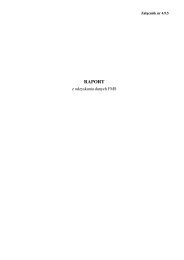- Page 1:
DIAGNOZA SPOŁECZNA 2015 WARUNKI I
- Page 4 and 5:
Merytoryczne opracowanie projektu b
- Page 7 and 8:
Diagnoza Społeczna 2015 5 Informac
- Page 9 and 10:
Diagnoza Społeczna 2015 7 Justyna
- Page 11 and 12:
Diagnoza Społeczna 2015 9 4.5.1.1.
- Page 13 and 14:
Diagnoza Społeczna 2015 11 7.3.1.
- Page 15 and 16:
Diagnoza Społeczna 2015 13 1. WST
- Page 17 and 18:
Diagnoza Społeczna 2015 15 korzys
- Page 19 and 20:
Diagnoza Społeczna 2015 17 najczę
- Page 21 and 22:
Diagnoza Społeczna 2015 19 Dostę
- Page 23 and 24:
Diagnoza Społeczna 2015 21 *** Ni
- Page 25 and 26:
Diagnoza Społeczna 2015 23 Dane D
- Page 27 and 28:
Diagnoza Społeczna 2015 25 3. METO
- Page 29 and 30:
Diagnoza Społeczna 2015 27 3.2.1.
- Page 31 and 32:
Diagnoza Społeczna 2015 29 3.3. Po
- Page 33 and 34:
Diagnoza Społeczna 2015 31 3.4. Ch
- Page 35 and 36:
Diagnoza Społeczna 2015 33 Tabela
- Page 37 and 38:
Diagnoza Społeczna 2015 35 W tegor
- Page 39 and 40:
Miesięczne dochody realne netto w
- Page 41 and 42:
Diagnoza Społeczna 2015 39 w marcu
- Page 43 and 44:
Najniższy miesięczny dochód potr
- Page 45 and 46:
Diagnoza Społeczna 2015 43 czący
- Page 47 and 48:
Diagnoza Społeczna 2015 45 Zróżn
- Page 49 and 50:
Diagnoza Społeczna 2015 47 1993 r.
- Page 51 and 52:
Proc. gospodarstw domowych Diagnoza
- Page 53 and 54:
Diagnoza Społeczna 2015 51 4.2. Wy
- Page 55 and 56:
Diagnoza Społeczna 2015 53 używki
- Page 57 and 58:
Diagnoza Społeczna 2015 55 Do prze
- Page 59 and 60:
Diagnoza Społeczna 2015 57 konto o
- Page 61 and 62:
Proc. zadłużonych gospodarstw dom
- Page 63 and 64:
Diagnoza Społeczna 2015 61 na inne
- Page 65 and 66:
Diagnoza Społeczna 2015 63 telewiz
- Page 67 and 68:
Diagnoza Społeczna 2015 65 rezerwa
- Page 69 and 70:
Diagnoza Społeczna 2015 67 4.3.3.
- Page 71 and 72:
Diagnoza Społeczna 2015 69 w poró
- Page 73 and 74:
Diagnoza Społeczna 2015 71 Połąc
- Page 75 and 76:
Diagnoza Społeczna 2015 73 Tabela
- Page 77 and 78:
Diagnoza Społeczna 2015 75 4.3.4 Z
- Page 79 and 80:
Diagnoza Społeczna 2015 77 Tabela
- Page 81 and 82:
Indeks zdrowia finansowego Diagnoza
- Page 83 and 84:
Diagnoza Społeczna 2015 81 4.3.4.3
- Page 85 and 86:
Diagnoza Społeczna 2015 83 Porówn
- Page 87 and 88:
Diagnoza Społeczna 2015 85 Tabela
- Page 89 and 90:
Diagnoza Społeczna 2015 87 Tabela
- Page 91 and 92:
Diagnoza Społeczna 2015 89 Białow
- Page 93 and 94:
Proc. gospodarstw domowych Diagnoza
- Page 95 and 96:
Proc. gospodarstw domowych Diagnoza
- Page 97 and 98:
Proc. gospodarstw domowych Proc. go
- Page 99 and 100:
Diagnoza Społeczna 2015 97 Tabela
- Page 101 and 102:
Diagnoza Społeczna 2015 99 z przed
- Page 103 and 104:
Diagnoza Społeczna 2015 101 genera
- Page 105 and 106:
Diagnoza Społeczna 2015 103 dynami
- Page 107 and 108:
Proc. gospodarstw domowych zmuszony
- Page 109 and 110:
teatru muzeum zakupu książki zaku
- Page 111 and 112:
Proc. gospodarstw domowych nie odcz
- Page 113 and 114:
Diagnoza Społeczna 2015 111 Różn
- Page 115 and 116:
Proc. gospodarstw Diagnoza Społecz
- Page 117 and 118:
Proc. gospodarstw Diagnoza Społecz
- Page 119 and 120:
Diagnoza Społeczna 2015 117 zróż
- Page 121 and 122:
Diagnoza Społeczna 2015 119 Tabela
- Page 123 and 124:
Diagnoza Społeczna 2015 121 Tabela
- Page 125 and 126:
Diagnoza Społeczna 2015 123 5 kwin
- Page 127 and 128:
Diagnoza Społeczna 2015 125 4.8. A
- Page 129 and 130:
Poziom braku zaspokojenia Diagnoza
- Page 131 and 132:
Diagnoza Społeczna 2015 129 4.9. R
- Page 133 and 134:
Diagnoza Społeczna 2015 131 Wyniki
- Page 135 and 136:
Diagnoza Społeczna 2015 133 Podsum
- Page 137 and 138:
Diagnoza Społeczna 2015 135 oraz b
- Page 139 and 140:
Diagnoza Społeczna 2015 137 4.9.1.
- Page 141 and 142:
Diagnoza Społeczna 2015 139 Omówi
- Page 143 and 144:
Możliwość dzielenia urlopu rodzi
- Page 145 and 146:
Diagnoza Społeczna 2015 143 na pol
- Page 147 and 148:
Diagnoza Społeczna 2015 145 Za pow
- Page 149 and 150:
Diagnoza Społeczna 2015 147 100% 8
- Page 151 and 152:
Wielka Brytania Holandia Norwegia W
- Page 153 and 154:
Diagnoza Społeczna 2015 151 na: ht
- Page 155 and 156:
Diagnoza Społeczna 2015 153 Dane z
- Page 157 and 158:
Diagnoza Społeczna 2015 155 zanoto
- Page 159 and 160:
Diagnoza Społeczna 2015 157 respon
- Page 161 and 162:
Diagnoza Społeczna 2015 159 Tabela
- Page 163 and 164:
Diagnoza Społeczna 2015 161 Tabela
- Page 165 and 166:
Diagnoza Społeczna 2015 163 Wyniki
- Page 167 and 168:
Diagnoza Społeczna 2015 165 pozost
- Page 169 and 170:
Diagnoza Społeczna 2015 167 Wcią
- Page 171 and 172:
Diagnoza Społeczna 2015 169 Tabela
- Page 173 and 174:
Diagnoza społeczna 2015 171 społe
- Page 175 and 176:
Diagnoza społeczna 2015 173 Sztand
- Page 177 and 178:
Diagnoza społeczna 2015 175 4.10.3
- Page 179 and 180:
Procent osób niemogących znaleź
- Page 181 and 182:
Diagnoza społeczna 2015 179 2014).
- Page 183 and 184:
Bezrobotni Sektor prywatny Bierni z
- Page 185 and 186:
Diagnoza społeczna 2015 183 5. IND
- Page 187 and 188:
Procent Diagnoza społeczna 2015 18
- Page 189 and 190:
Diagnoza społeczna 2015 187 5.1.2.
- Page 191 and 192:
Diagnoza społeczna 2015 189 50 40
- Page 193 and 194:
Diagnoza społeczna 2015 191 Sprawd
- Page 195 and 196:
Diagnoza społeczna 2015 193 Tabela
- Page 197 and 198:
Depresja Diagnoza społeczna 2015 1
- Page 199 and 200:
Dobrostan psychiczny Ocena życia D
- Page 201 and 202:
Zadowolenie z życia Diagnoza społ
- Page 203 and 204:
Proc. eudajmonistów Proc. eudajmon
- Page 205 and 206:
Proc. nadużwających alkoholu Dzie
- Page 207 and 208:
Diagnoza społeczna 2015 205 Tabela
- Page 209 and 210:
Diagnoza społeczna 2015 207 Zasadn
- Page 211 and 212:
Diagnoza społeczna 2015 209 się n
- Page 213 and 214:
Proc. bardzo szczęśliwych Ogólny
- Page 215 and 216:
Przwdopodobieństwo urodzenia dziec
- Page 217 and 218:
Ogólny dobrostan subiektywny Ogól
- Page 219 and 220:
Diagnoza społeczna 2015 217 5.5. F
- Page 221 and 222:
Diagnoza społeczna 2015 219 Tabela
- Page 223 and 224:
Współczynnik Giniego * 100 Proc.
- Page 225 and 226:
Proc. Diagnoza społeczna 2015 223
- Page 227 and 228:
Diagnoza społeczna 2015 225 szym p
- Page 229 and 230:
Diagnoza społeczna 2015 227 Tabela
- Page 231 and 232:
Diagnoza społeczna 2015 229 Tabela
- Page 233 and 234:
Liczba symptomów Proc. zadowolonyc
- Page 235 and 236:
Diagnoza społeczna 2015 233 Tabela
- Page 237 and 238:
Jakość życia Zadowolenie ze zdro
- Page 239 and 240:
Diagnoza społeczna 2015 237 Na tle
- Page 241 and 242:
Poważna choroba (proc.) Zadowoleni
- Page 243 and 244:
Ogólny wskaźnik zaburzeń somatyc
- Page 245 and 246:
Diagnoza społeczna 2015 243 Cztery
- Page 247 and 248:
Diagnoza społeczna 2015 245 Tabela
- Page 249 and 250:
Diagnoza społeczna 2015 247 Tabela
- Page 251 and 252:
Diagnoza społeczna 2015 249 Tabela
- Page 253 and 254:
Diagnoza społeczna 2015 251 5.8. S
- Page 255 and 256:
Skłonności samobójcze Diagnoza s
- Page 257 and 258:
Skłonności samobójcze Diagnoza s
- Page 259 and 260:
Diagnoza społeczna 2015 257 Tabela
- Page 261 and 262:
Procent rozwodzących się Procent
- Page 263 and 264:
Kobiety Mężczyźni Procent Diagno
- Page 265 and 266:
Proc. Diagnoza społeczna 2015 263
- Page 267 and 268:
Diagnoza społeczna 2015 265 Tabela
- Page 269 and 270:
Diagnoza społeczna 2015 267 Tabela
- Page 271 and 272:
Diagnoza społeczna 2015 269 Tabela
- Page 273 and 274:
Pragnienie życia Skłonności samo
- Page 275 and 276:
Diagnoza społeczna 2015 273 Brak p
- Page 277 and 278:
Diagnoza społeczna 2015 275 Tabela
- Page 279 and 280:
Procent Diagnoza społeczna 2015 27
- Page 281 and 282:
Diagnoza społeczna 2015 279 Tabela
- Page 283 and 284:
Diagnoza społeczna 2015 281 5.10.4
- Page 285 and 286:
Diagnoza społeczna 2015 283 Intere
- Page 287 and 288:
Diagnoza społeczna 2015 285 Tabela
- Page 289 and 290:
Diagnoza społeczna 2015 287 nicuj
- Page 291 and 292:
Poczucie zagrożenia w miejscu zami
- Page 293 and 294:
Diagnoza społeczna 2015 291 Tabela
- Page 295 and 296:
Diagnoza społeczna 2015 293 5.11.
- Page 297 and 298:
Proc. nieszczęśliwych i niezbyt s
- Page 299 and 300:
Kapitał społeczny Proc. samotnych
- Page 301 and 302:
Diagnoza społeczna 2015 299 Ofiara
- Page 303 and 304:
Diagnoza społeczna 2015 301 Tabela
- Page 305 and 306: Diagnoza społeczna 2015 303 Tabela
- Page 307 and 308: Diagnoza społeczna 2015 305 Tabela
- Page 309 and 310: Diagnoza społeczna 2015 307 Tabela
- Page 311 and 312: Diagnoza społeczna 2015 309 Tabela
- Page 313 and 314: Diagnoza społeczna 2015 311 Ball,
- Page 315 and 316: Diagnoza społeczna 2015 313 Myers
- Page 317 and 318: Diagnoza społeczna 2015 315 Pięć
- Page 319 and 320: Diagnoza społeczna 2015 317 Postaw
- Page 321 and 322: Diagnoza społeczna 2015 319 6.2. D
- Page 323 and 324: Diagnoza społeczna 2015 321 Grupa
- Page 325 and 326: Diagnoza społeczna 2015 323 aktywn
- Page 327 and 328: Diagnoza społeczna 2015 325 Tabela
- Page 329 and 330: Diagnoza społeczna 2015 327 bądź
- Page 331 and 332: Diagnoza społeczna 2015 329 6.2.5.
- Page 333 and 334: Diagnoza społeczna 2015 331 Podsta
- Page 335 and 336: Diagnoza społeczna 2015 333 6.3. K
- Page 337 and 338: Diagnoza społeczna 2015 335 80 76
- Page 339 and 340: Diagnoza społeczna 2015 337 wodowy
- Page 341 and 342: Kapitał społeczny Kapitał społe
- Page 343 and 344: Dochód osobisty Diagnoza społeczn
- Page 345 and 346: proc. proc. Diagnoza społeczna 201
- Page 347 and 348: Diagnoza społeczna 2015 345 inwest
- Page 349 and 350: Diagnoza społeczna 2015 347 2015 D
- Page 351 and 352: Diagnoza społeczna 2015 349 PiS wy
- Page 353 and 354: Diagnoza społeczna 2015 351 A B R
- Page 355: Proc. Diagnoza społeczna 2015 353
- Page 359 and 360: Diagnoza społeczna 2015 357 do 1 M
- Page 361 and 362: Procent gospodarstw domowych Diagno
- Page 363 and 364: Diagnoza społeczna 2015 361 7.1.6.
- Page 365 and 366: Procent Diagnoza społeczna 2015 36
- Page 367 and 368: Diagnoza społeczna 2015 365 medió
- Page 369 and 370: Diagnoza społeczna 2015 367 zmiany
- Page 371 and 372: Diagnoza społeczna 2015 369 Zachod
- Page 373 and 374: procent użytkowników którzy korz
- Page 375 and 376: czas poświęcany na oglądanie tel
- Page 377 and 378: Diagnoza społeczna 2015 375 7.4. S
- Page 379 and 380: Diagnoza społeczna 2015 377 wiele
- Page 381 and 382: Diagnoza społeczna 2015 379 Więks
- Page 383 and 384: Diagnoza społeczna 2015 381 W ocen
- Page 385 and 386: Diagnoza społeczna 2015 383 nego u
- Page 387 and 388: Diagnoza społeczna 2015 385 Zasię
- Page 389 and 390: Diagnoza społeczna 2015 387 Intens
- Page 391 and 392: Diagnoza społeczna 2015 389 Tabela
- Page 393 and 394: Diagnoza społeczna 2015 391 na gł
- Page 395 and 396: Diagnoza społeczna 2015 393 utrzym
- Page 397 and 398: Diagnoza społeczna 2015 `395 Tabel
- Page 399 and 400: Wysokość dochodu Nadużywanie alk
- Page 401 and 402: Dobrostan psychiczny Jakość życi
- Page 403 and 404: Miesięczny dochód osobisty netto
- Page 405 and 406: Poczucie dyskryminacji Proc. Poczuc
- Page 407 and 408:
Poczucie dyskryminacji Poczucie dys
- Page 409 and 410:
Poczucie dyskryminacji Poczucie dys
- Page 411 and 412:
Diagnoza społeczna 2015 409 Najwi
- Page 413 and 414:
Diagnoza społeczna 2015 411 Równi
- Page 415 and 416:
Diagnoza społeczna 2015 413 8.5.3.
- Page 417 and 418:
Skumulowana zmiana procentowa Diagn
- Page 419 and 420:
Klasa miejscowości zamieszkania Wi
- Page 421 and 422:
Diagnoza społeczna 2015 419 (ok. 3
- Page 423 and 424:
Styl życia Typ rodziny Styl życia
- Page 425 and 426:
Diagnoza społeczna 2015 423 Tabela
- Page 427 and 428:
Diagnoza społeczna 2015 425 Tabela
- Page 429 and 430:
Diagnoza społeczna 2015 427 Tabela
- Page 431 and 432:
Diagnoza społeczna 2015 429 Tabela
- Page 433 and 434:
Jakość życia Jakość życia Dia
- Page 435 and 436:
Jakość życia Jakość życia Dia
- Page 437 and 438:
Diagnoza społeczna 2015 435 Tabela
- Page 439 and 440:
Diagnoza społeczna 2015 437 Tabela
- Page 441 and 442:
Procentowa zmiana Skumulowana zmian
- Page 443 and 444:
Współczynnik Giniego * 100 Zmieni
- Page 445 and 446:
Diagnoza społeczna 2015 443 ANEKSY
- Page 447 and 448:
Diagnoza społeczna 2015 445 2. Rea
- Page 449 and 450:
Diagnoza społeczna 2015 447 1 Nume
- Page 451 and 452:
Diagnoza społeczna 2015 449 1 Nume
- Page 453 and 454:
Diagnoza społeczna 2015 451 2. Dla
- Page 455 and 456:
Diagnoza społeczna 2015 453 13. Ja
- Page 457 and 458:
Diagnoza społeczna 2015 455 5. W j
- Page 459 and 460:
Diagnoza społeczna 2015 457 J. KUL
- Page 461 and 462:
Diagnoza społeczna 2015 459 7. Czy
- Page 463 and 464:
Diagnoza społeczna 2015 461 ezpiec
- Page 465 and 466:
Diagnoza społeczna 2015 463 INSTRU
- Page 467 and 468:
Diagnoza społeczna 2015 465 11. Cz
- Page 469 and 470:
Diagnoza społeczna 2015 467 41. Cz
- Page 471 and 472:
Diagnoza społeczna 2015 469 57. Po
- Page 473 and 474:
Diagnoza społeczna 2015 471 63. Ch
- Page 475 and 476:
Diagnoza społeczna 2015 473 71. Il
- Page 477 and 478:
Diagnoza społeczna 2015 475 102. C
- Page 479 and 480:
Diagnoza społeczna 2015 477 Na kol
- Page 481 and 482:
Diagnoza społeczna 2015 479 ******
- Page 483 and 484:
Diagnoza społeczna 2015 481 Jeśli
- Page 485 and 486:
Diagnoza społeczna 2015 483 Należ
- Page 487 and 488:
Diagnoza społeczna 2015 485 DZIAŁ
- Page 489 and 490:
Diagnoza społeczna 2015 487 Dla os
- Page 491 and 492:
Diagnoza społeczna 2015 489 -- now
- Page 493 and 494:
Diagnoza społeczna 2015 491 wiersz
- Page 495 and 496:
Diagnoza społeczna 2015 493 ANEKS
- Page 497 and 498:
Diagnoza społeczna 2015 495 ANEKS
- Page 499 and 500:
Diagnoza społeczna 2015 497 4. War
- Page 501 and 502:
Diagnoza społeczna 2015 499 ANEKS
- Page 503 and 504:
Diagnoza społeczna 2015 501 Podsta
- Page 505 and 506:
Diagnoza społeczna 2015 503 7.4. R
- Page 507 and 508:
Diagnoza społeczna 2015 505 oparto
- Page 509 and 510:
Diagnoza społeczna 2015 507 ANEKS
- Page 511 and 512:
Diagnoza społeczna 2015 509 Kapita
- Page 513 and 514:
Diagnoza społeczna 2015 511 Dobros
- Page 515 and 516:
Diagnoza społeczna 2015 513 Dobrob
- Page 517 and 518:
Diagnoza społeczna 2015 515 Dobros
- Page 519 and 520:
Diagnoza społeczna 2015 517 Dobrob
- Page 521 and 522:
Diagnoza społeczna 2015 519 Dobros
- Page 523 and 524:
Diagnoza społeczna 2015 521 Dobros
- Page 525 and 526:
Diagnoza społeczna 2015 523 Patolo
- Page 527 and 528:
Diagnoza społeczna 2015 525 Dobros
- Page 529:
Diagnoza społeczna 2015 527 Stres





